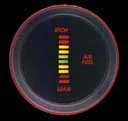
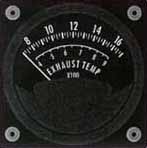
About oxygen (O2) sensor & EGT gauges


O2 sensor gauges are a good way to tune any automobile. I have been using one (K&N) on my 1970 Plymouth GTX for 8 years now and it makes carb tuning a snap! How can you go wrong when there's a gauge staring you in the face? Beats trying to read plugs or guessing by a country mile.
More important is it will keep you from burning up your Turbo car when your cranking da' boost!
Racing and
looking for a VERY precise way to monitor your fuel curve? EGT gauges measure
the temperature of exhaust gas flow and for use at WOT they are better then O2
gauges. What I would recommend if your really serious about running your car to
the max is an O2 gauge to monitor your engine at idle and cruise AND a EGT for
use at WOT.
How they work
O2 sensor
An O2 sensor generates voltage based on the oxygen in the exhaust flow. Using this data your car's computer modifies the base pulsewidth of your injectors for maximum gas mileage and emissions. During wide open throttle however, the O2 sensor is ignored and the computer uses a factory preset pulsewidth for the injectors.
Your gauge displays this voltage output in a bar graph: each "bar" represents .1 volts. (assuming your using a gauge with just 10 bars, some have 20 now) .5 volts is a perfect 14.7 to 1 fuel ratio- perfect for max gas mileage that is. For max power & engine safety, 12-11 to 1 is recommended (9-10 bars)
Note: NORMAL O2 sensors work in the 0.0 to 1.0 volt range.
EGT gauge
The EGT gauge uses a thermocouple installed in the exhaust manifold runner (either screwed in or clamped on style) which is exposed directly to the exhaust flow.
What's the best temperature to shoot for while tuning?? A hot subject for sure! (ouch!) The factory rates the TURBO exhaust components at 1650F at a steady state operation- This means while cruising down the highway at normal throttle, engine in O2 feedback mode with the fuel mixture at 14.7:1 exhaust temps CAN (not will) reach as high as 1650F. At WOT however the ECU goes into full rich mode and exhaust gases are cooler due to the extra fuel and I have seen cars set up from the factory as low as 1250 (which is a little on the rich side but SAFE).
So
what this all mean? If someone asked me for a magic number I would say 1500F
degrees would be idea at WOT. I HAVE gone as high as 1650F when I was making
around 300 hp with no ill effects, however... As the power goes up the demands
on the parts get higher and higher... If I tried running even 1600F now at the
power level I'm at I'd pop a headgasket or torch a piston in a millisecond.
Ok, I want a O2 gauge; who sells them?

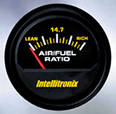
On
left: Intellitronix ITC-TH7009/7009, $30 Note: has nice 10
LED bar graph with 3 colors. On the right is their analog model which I don't recommend due to it's slow response
time & it's less accurate compared to the digital model.
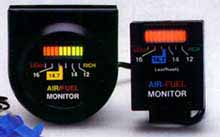
K&N 85-2442
(round) or 85-2439 (square) .... $50
Note: round is 2 color,
square has just red. 10 LED
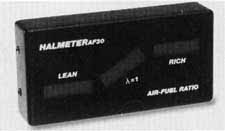
HALMETER AF30
......................................................... $140
Note: 30 LED graph
is nice but worth $140? (square)
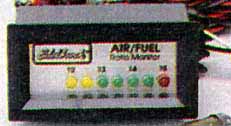
Edelbrock EDL-6593 ....................................... $126
Note: with O2 sensor and only 7 LED's (square)
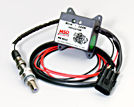
MSD MSD-8933 .................................................. $149
Note: with O2 sensor and only 2 LED's (square)
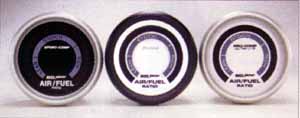
Autometer sells a trio of air fuel gauges with 20 led's but they only light one at a time which could make reading them in a hurry tricky.
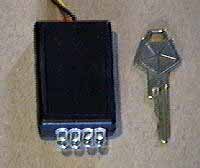
Dawes
Devices makes a small handy unit for
installing just about anywhere that just reads in the upper range- perfect for
WOT operation.
EGT Gauges are sold by a wide variety of gauge manufactures.
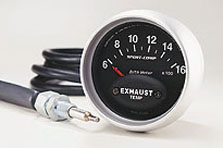

On the left is an Autometer unit and sender, on the right a Westach gauge.
When ordering your gauge make sure you order the thermocouple at the same time- They don't come as a set due to the variety of lengths and attaching methods. There are many other EGT gauges out including units with alarms, buzzers and even memory playback.
Oxygen sensors: more than one kind? and why?
83-86 1 wire
sensor
87-88 3 wire sensor
89-present 4 wire
sensor
In the beginning, there was the one wire O2 sensor; and it was good.
BUT there was a problem with the sensor in regards to warming up- it was too slow. Oxygen sensors don't start working till 600F. So the engineers went back to the drawing board and came up with a new O2 sensor- the THREE wire. It had a heating element and a ground wire so that the sensor heated up right quick! BUT there was one more problem. The sensor itself was grounded by the turbo housing/exhaust manifold and it was throwing the sensor off by almost a tenth of a volt by excessive resistance. SO back to the drawing board again and the FOUR wire sensor was born. It had a ground just for the sensor!
That's why on some cars with one or three wire sensors the bar graph won't read 10 bars even when fuel is practically rolling out the tailpipe. They are losing that last .1 volt in the exhaust housing and/or wiring.
I converted my 86 Turbo
Z and my 85 K-car to the 4 wire sensors so that my O2 gauges were reading
more accurately.
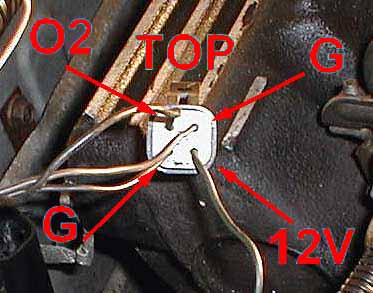
Here is a picture of the BACKSIDE of the connector of the CARS wiring harness.
G & G are grounds of course, 12V feed for the heating element and O2 is the signal feed to the computer.
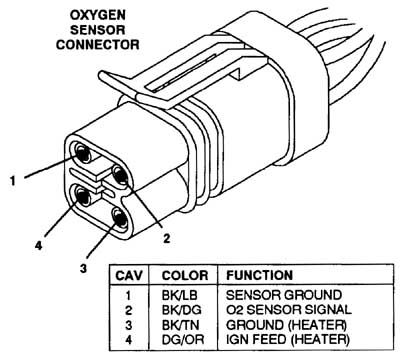
THE
GROUNDS ARE VERY IMPORTANT!! WHEN IN DOUBT RUN THEM DIRECTLY TO THE BATTERY. I
HAVE SEEN COUNTLESS PEOPLE COMPLAIN THAT THEIR GAUGES WERE NOT READING TO IT'S
FULL RANGE AND IT'S BECAUSE THEY HAD BAD GROUNDS. DO NOT USE A SINGLE WIRE
FOR BOTH GROUNDS.
Installation of O2 gauge
1. Pick a
spot where you can easily see it.
2. Run power from
a key on connection (the radio fuse is fine)
3.
Run the ground directly to the firewall or even the battery! Do not attach to any other ground wire or bracket!
4. On 84-87 you can
tap the O2 sensor signal wire right off the logic module inside the car; it's pin number 18 of the logic module BLUE connector, it's the only SOLID
BLACK wire.
5. 88-present
you will have to tap off the wiring under the hood near the sensor.
For 3 wire sensors there are 2 white wires and 1 black- it's the black
wire.
For 4 wire sensors there are 2 white wires, 1 gray and 1 black- it's the
black wire.
I leave it up to you
on how to connect your wiring; soldering is best, good tape and heat shrink
tubing is also a real good idea here.
Installation
of EGT gauge
Pick
a runner to install the probe in- I recommend cylinder #4. How it's installed
will depends on which probe you get, I prefer the clamp on model. It's as simple
as drilling a hole, inserting the probe and tightening the clamp around the
exhaust runner.
Modes
of operation (O2 gauge)
1. Key on, engine off; 1 bar or less (duh)! (unless you have a voltage leakage problem in your wiring)
2. Engine running first 1-3 minutes; bar will slowly climb to 9-10 bars (.9 to 1.0 volts) after the computer sees .9 volts, it will start O2 feedback. If it's VERY cold out it will not begin O2 feedback till the engine warms up a bit regardless what the O2 sensor is reading.
3. Engine at normal operating temp; at cruise bouncing up and down fairly quickly. At idle will be about the same, maybe a shade slower.
4. 3/4 throttle, normal temp, 4-7psi/boost; will rise to 6-8 bars (.6 to .8 volts), no bounce.
5. WIDE
OPEN THROTTLE!, any temp, 1-14psi/boost; 9-10
bars (.9 volts), no bounce.
Modes of operation (EGT)
1) Idle anything from 800F-to 1100F
2) Cruise around 1300F to 1600F
3) WOT I'd shoot for 1500F
A note on
EGT gauges- They ARE affected by outside temps and you do have to take them into
consideration. If your racing on a 100 degree day and the next time you race
it's a 50 degrees out guess what? You gauge will be reading 50 degrees different
with no other changes.
Troubleshooting
(O2 gauge)
1. Gauge
blank, no lights of any kind; check power,
check grounds.
2. Have
rich/lean/air fuel light up, but no bar graph;
bad connection to O2 sensor, bad O2.
3. Bounce
very sluggish at cruise and idle; O2 sensor
on its way out, replace.
4. Only
reads 8 bars (.8 volts) or less at WOT; poor
ground to gauge, poor ground O2
sensor, lean fuel mixture, bad sensor. Note:
See below on sensors.
5. Bar
graph rises to 10 bars (1.0 volts) and stays;
voltage leakage in O2 wiring or bad sensor. Note: Engine oil leakage onto sensor plug will do this.
How to tell if my grounds or a sensor is a problem (low bar graph readings)
Start the car and let it idle. Pull off the inlet hose at the throttle body and enrichen the engine by spraying a fuel into the throttle (BE CAREFUL!). Carb cleaner or some propane (not lit I hope) from a shop torch works fine. Practically stall the engine out, have someone observe the gauge when you do this. It should spike to 9-10 bars. If not:
1. 9 bars
with a 1 or 3 wire sensor is fairly normal- see sensor section.
2. Less then 9 bars;
Poor ground to gauge or sensor going bad. A bad
sensor will also show itself as sluggish operation (slow bounce).
This test will eliminate your fuel system as a cause of a low gauge reading because you are supplying the extra fuel instead of the car.
A quick fix from a reader...
Hi, Gary!
You might want to mention a repair technique that works more than half of the time. Sooner
or later someone will touch the orange O2 gauge wire to the 12V positive
source by accident. Then all 10 lights stay lit all the time, after it's
hooked up properly.
To fix it, you just need to touch all 3 gauge wires together (engine off, and power disconnected) and it'll work normal again when you hook it up and turn on the power.
I've done this about 6 times, and it worked about 4 times.
No, I'm not an idiot! LOL! I only wired a gauge wrong ONCE. The second time, I was going to do a quick underhood test of a gauge. I had connected the ground already, and the orange wire slipped out of my hand and swung down right into the positive battery post! The other 4 times were all cases where other people messed up, and I fixed most of them...
Gus Mahon